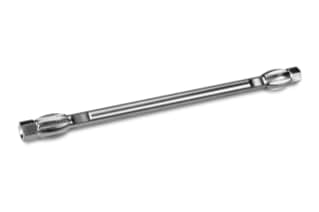
|
Chemistry |
Phenyl |
|
Separation Mode |
Reversed Phase |
|
Particle Substrate |
Hybrid |
|
pH Range Min |
1 pH |
|
pH Range Max |
12 pH |
|
Maximum Pressure |
6000 psi (415 Bar) |
|
Endcapped |
Yes |
|
Bonding Technology |
Phenyl-Hexyl |
|
Silanol Activity |
Low |
|
Particle Shape |
Spherical |
|
Particle Size |
3.5 µm |
|
Endfitting Type |
Waters |
|
Pore Size |
130 Å |
|
Format |
Column |
|
Surface Area |
185 |
|
System |
HPLC |
|
Particle Technology |
BEH |
|
USP Classification |
L11 |
|
Inner Diameter |
4.6 mm |
|
Length |
150 mm |
|
Carbon Load |
15 % |
|
UNSPSC |
41115709 |
|
Brand |
XBridge |
|
Product Type |
Columns |
|
Units per Package |
1 pk |
XBridge BEH Phenyl Column, 130Å, 3.5 µm, 4.6 mm X 150 mm, 1/pk
Long known for their alternate selectivity and use when analytes contain an aromatic ring, phenyl columns have been under-utilized due to their inadequate stability under low pH conditions. But methods development scientists are no longer limited by pH conditions when a phenyl LC column is called for. With the innovative bonding and end-capping of BEH particle technology, XBridge BEH Phenyl Columns are able to provide high and low pH stability. The result is the most stable and reproducible phenyl column available.
As the most chemically stable phenyl sorbent on the market, columns like the XBridge BEH Phenyl-Hexyl XP Column, 130Å, 2.5 µm, 4.6 mm X 50 mm, 1/pk and other similar lab equipment offer ultra-low column bleed, superior peak shape, and extended column lifetimes. By combining trifunctional bonding of the phenyl hexyl-ligand and proprietary end-capping methods, the XBridge BEH Phenyl Column is the industry leader for stability at low pH without sacrificing peak shape.
Compared to straight-chain-alkyl columns and embedded-polar-group columns, XBridge BEH Phenyl columns offer alternate selectivity, especially for compounds that contain an aromatic moiety. Chromatographers can benefit from the increased flexibility in developing orthogonal methods when it comes to challenging separations. This is possible through the use of BEH Technology, a new milestone in chromatography that allows the full power of pH to be harnessed.
Achieve a successful separation of aromatic acids with XBridge BEH Phenyl columns’ selectivity (possible via pi-pi interactions) and improved chemical stability, enabling column longevity and robust operations at low pH levels. XBridge BEH Phenyl columns will give you the flexibility to work with an unparalleled range of mobile phase pH and temperature while allowing seamless method migration to UPLC technology.
How Should XBridge BEH Phenyl Columns Be Stored?
For periods exceeding four days at room temperature, the XBridge family of columns should be stored in 100% acetonitrile. If used with elevated temperatures and/or at pH extremes, immediately store the columns in 100% acetonitrile in order to improve column lifetime. Columns should not be stored in highly aqueous (<20% organic) mobile phases to prevent bacterial growth. If the mobile phase contains a buffer salt, flush the column with 10 column volumes of HPLC grade water and replace with 100% acetonitrile for storage. If this is not done, it can lead to precipitation of the buffer salt.